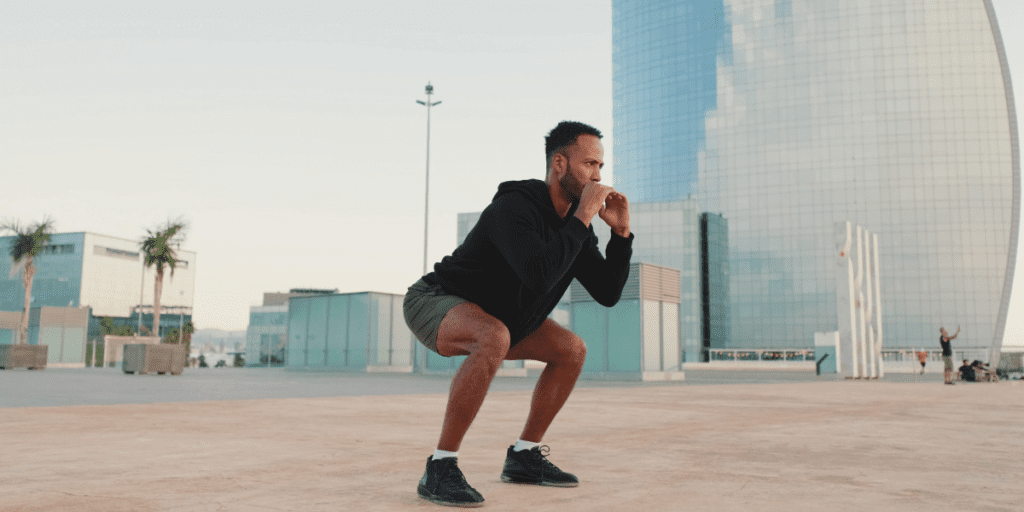Squatting is a foundational compound exercise in strength training, renowned for its ability to target multiple muscle groups simultaneously, including the quadriceps, hamstrings, glutes, and lower back. However, amidst the benefits, some individuals encounter shoulder pain during squats, hindering their progress and potentially leading to injury. In this comprehensive guide, we’ll delve into the causes of shoulder pain while squatting, strategies for prevention, and effective solutions to alleviate discomfort and optimize your squatting performance.

Understanding the Causes
Shoulder pain during squats can arise from various factors, ranging from improper technique to underlying biomechanical issues. Here are some common causes:
Improper Technique:
Maintaining proper form is paramount during squats. Failure to keep the chest up, shoulders back, and core engaged can result in rounded shoulders or excessive internal rotation, placing undue stress on the shoulder joints.
Limited Shoulder Mobility:
Restricted mobility in the shoulders, often attributed to tightness in the chest, lats, or upper back muscles, can impede the proper execution of squats and predispose individuals to shoulder pain.
Muscle Imbalances:
Discrepancies in muscle strength and activation between the anterior and posterior shoulder muscles can lead to instability and discomfort during squats. Overdeveloped chest muscles and weak upper back muscles may contribute to forward shoulder positioning.
Previous Injuries or Conditions:
Individuals with a history of shoulder injuries, such as rotator cuff tears or impingement syndrome, may experience heightened sensitivity or pain while squatting. Pre-existing shoulder conditions can exacerbate symptoms during exercise.


Prevention Strategies
Preventing shoulder pain during squats involves a multifaceted approach that addresses biomechanics, mobility, and muscle balance. Here’s how to mitigate the risk:
- Focus on Technique: Prioritize proper squatting technique, emphasizing a neutral spine, chest elevation, and shoulder retraction throughout the movement. Avoid excessive forward lean and maintain a stable core to alleviate strain on the shoulders.
- Improve Shoulder Mobility: Incorporate dynamic and static stretches targeting the shoulders into your warm-up routine. Exercises such as shoulder dislocations, wall slides, and thoracic spine mobilization can enhance shoulder mobility and optimize squat form.
- Correct Muscle Imbalances: Counteract overactive chest muscles by strengthening the muscles of the upper back, including the rhomboids, traps, and rear deltoids. Incorporate exercises such as rows, face pulls, and band pull-aparts to promote shoulder stability and alignment.
- Modify Grip and Hand Placement: Experiment with different grip variations during squats to alleviate shoulder discomfort. A wider grip or adopting a thumbless grip (false grip) may reduce strain on the shoulders and enhance comfort during the exercise.
- Gradual Progression: Avoid overloading the shoulders by gradually increasing the intensity and volume of your squatting routine. Progression should be gradual and tailored to individual strength levels to minimize the risk of injury.
Solutions for Alleviating Shoulder Pain
In addition to preventive measures, implementing targeted solutions can help alleviate shoulder pain experienced during squats. Here are some effective strategies:
Soft Tissue Release: Utilize foam rolling, lacrosse ball massage, or self-myofascial release techniques to alleviate tension and tightness in the muscles surrounding the shoulder joint. Target areas such as the chest, lats, and upper back to promote relaxation and improve mobility.
Posture Correction Exercises: Incorporate exercises that promote proper posture and shoulder alignment, such as scapular retractions and shoulder blade squeezes. These exercises help reinforce optimal shoulder positioning and reduce the risk of discomfort during squats.
Active Recovery and Rest: Allow adequate time for recovery between squatting sessions to prevent overuse and potential aggravation of shoulder pain. Engage in active recovery activities such as swimming, cycling, or yoga to promote blood flow and tissue repair.
Professional Assessment and Treatment: If shoulder pain persists despite conservative measures, seek evaluation from a qualified healthcare professional or physical therapist. They can conduct a thorough assessment, identify underlying issues, and prescribe targeted interventions, such as manual therapy or corrective exercises, to address the root cause of the pain.


Need Help With Shoulder Pain?
Experience relief and regain mobility at Innovative Healthcare Centers, your premier destination for physical therapy and rehabilitation services. Our dedicated team of professionals is committed to providing personalized care and innovative treatment solutions tailored to your unique needs. Don’t let shoulder pain hinder your quality of life any longer—take the first step towards recovery by scheduling an appointment with us today. Rediscover the joy of pain-free movement and embark on the journey to a healthier, happier you with Innovative Healthcare Centers.